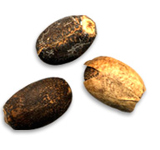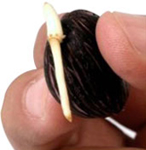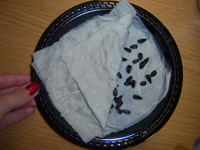Jatropha Seed Germination
Jatropha curcas is a perennial shrub that grows in semi-arid areas and produces fruit that contain seeds with high oil content. That oil can be extracted and converted into a combustible fuel, such as biodiesel. Jatropha biodiesel can potentially replace a significant part of the petrodiesel demand. These small trees produce fruit in the winter time, which is ready to harvest several months later. The Bioenergy Summer School Interns had been fortunate enough to get their hands on different types of Jatropha seeds to experiments with several germination methods. Although the efforts were unsuccessful in producing germinated seeds that were strong enough to plant, the following are methods that the interns employed in efforts to germinate their seeds.
Jatropha curcas seeds are shaped like a bean and have a thick, hard dark brown shell – which is characteristic of seeds that show difficulty in germinating. The seeds are known for their inability to store for long periods and it is suspected that the interns’ failure to germinate the given seeds is attributed to their age.
Those interested in growing Jatropha or those who have run into trouble germinating Jatropha or other seeds should reference the methods below. One should note that the following experimentation took place in the summer months of July through August in Gainesville, Florida, and no chemicals were used in the germination process. Below are several methods that the interns employed in the process of germinating Jatropha seeds.


Method 1
Soaking seeds in water at room temperature
It should be noted that when Jatropha seeds were soaked in water, the water turned a brown color and produced an unpleasant odor. We suspect this was due to the toxins in the skin of the seeds.
Method 2
Soaking seeds in damp cloth at room temperature (see pictures below)
This conventional method of germinating seeds has work great on other oil crops such as sunflower, peanut and soy. However the interns saw no result in germinating seeds with this method.


Method 3
After recognizing that the seeds crust has been hardened due to the age of the seeds we tried to nick the seeds at the poles to free to cotyledon to allow for easier sprouting.
Method 4
Germination in pots with 50/50 mix of potting soil and sand
We attempted to germinate Jatrpha seeds in pots. The pots contained a soil mixture with 50% sand content to recreate the native conditions in the semi-arid areas. These pots were watered every other day and were left out at full exposure to the sun. The seeds were planted about 1 inch deep into the soil.
Method 5
Germinating in pots with 100% potting soil
The potting soil did not provide any significant improvement in germination speed. The seeds were planted about 1 inch deep into the soil.
Method 6
Germinating in pots with 50/50 sand and potting soil enclosed in zip-lock bags
Potting soil was mixed with sand in a 1:1 ratio. The soil was thoroughly watered and the seed was placed about 1 inch deep into the wet soil. Then the pot was placed in a plastic zip-loc bag and left outside in partial shade. The bag was left partially open to ensure that the microenvironment remains aerated while keeping a constant moisture level. Caution should be used when placing bags outside because the direct sun makes the conditions too hot to germinate and the seeds ‘bake’ in the soil. We suspect that although our bags were placed in partial shade, several trials of this method still made the conditions too hot, due to the high temperatures outside.
This method was especially favorable to us as we saw one of the seeds sprout. In literature, this method is proven to germinate seeds up to twice as fast.